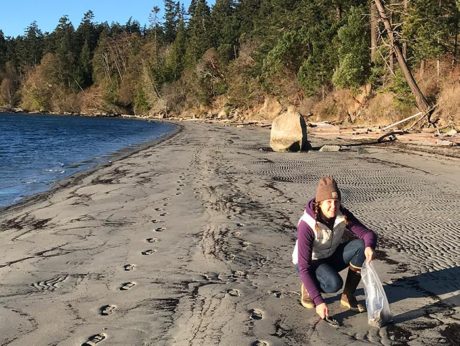Local Research Finds New Forage Fish Spawning Beaches
Posted January 9, 2019 at 5:49 am by Tim Dustrude

Jess Newley, Friends of the San Juans’ Marine Program Assistant, surveys for Pacific sand lance on Shaw Island – Contributed photo
Did you know that our local sand and gravel beaches nurture incubating fish eggs? These eggs are virtually undetectable to the naked eye and come from two species of marine fish – surf smelt and Pacific sand lance. These species are among those referred to as “forage fish” for the vital role they play in marine food webs. Forage fish are included throughout task force recommendations for the recovery of the Southern Resident Orca, including completing surveys to map habitat and expanded restoration and protection of spawning beaches.
Surf smelt spawn year-round in San Juan County while Pacific sand lance, a favorite food item for juvenile as well as adult chinook salmon, only spawn in the winter months. Until recently, just eight sand lance spawning sites were documented across the county’s 400 miles of marine shoreline as field survey efforts have been limited by winter weather conditions and nighttime low tides. Friends of the San Juans, with funding from the Wheeler Family Foundation and the Washington Salmon Recovery Funding Board, recently began a three-year research program to identify sand lance spawning habitat.
“I am excited to report that in just the first month of our 2018 sampling effort we have identified four additional spawning beaches in the county – two sand lance and two surf smelt,” states Tina Whitman, Friends Science Director, “this information will help improve the efficiency and success of salmon habitat protection and restoration efforts.”
Friends of the San Juans’ exploratory surveys are being conducted at public and private beaches during the winter sand lance spawning season and will continue for the next two winters. It has been over 15 years since Friends of the San Juans led the last comprehensive surveys for spawning sand lance in San Juan County. As with the previous survey results, Friends of the San Juans will use the knowledge gained from this mapping effort to determine where protection and restoration of beach habitat is most needed.
The project, which engages waterfront property owners, local students and volunteers is also a great way to get the community involved in marine research. There are lots of ways to help with the forage fish project – volunteering with beach survey efforts, allowing access to your private beach for research or supporting shoreline habitat projects. To learn more please contact Friends of the San Juans at tina@sanjuans.org or 360-378-2319 or visit our website at www.sanjuans.org.
You can support the San Juan Update by doing business with our loyal advertisers, and by making a one-time contribution or a recurring donation.
Categories: Environment, Science, Wildlife










No comments yet. Be the first!
By submitting a comment you grant the San Juan Update a perpetual license to reproduce your words and name/web site in attribution. Inappropriate, irrelevant and contentious comments may not be published at an admin's discretion. Your email is used for verification purposes only, it will never be shared.